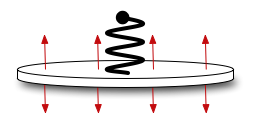One-Mass - Mono-directional (Harmonic Oscillator)
Description
A simple and inexpensive mass and spring model that can serve as lips, among other things. The harmonic oscillator models a mass attached to a spring of a given stiffness, fixed at one end. The frequency of resonance of the object is given by the formula 1/(2 pi) sqrt(stiffness / mass).

Syntax and Default Values
A Harmonic Oscillator can be created using the following Mlys (Max), mlys.lua, or Lisp syntax:
In Modalys for Max, this object is named mlys.harmonic-oscillator:
TODO
modalys.make_object{ kind="harmonic-oscillator", name="MyHarmonicOscillator",
mass=0.1, stiffness=15000, freqloss=100, constloss=10 }
(make-object 'harmonic-oscillator
(mass .01)
(stiffness 15000)
(freq-loss 100)
(const-loss 10))
Parameters
All physical parameters can be numerical values or controllers.
- mass: The mass of the small mass in kg.
- stiffness: The stiffness of the spring in the 'normal direction.
- freq-loss: The usual frequency loss parameter. See the General Object Information for more info.
- const-loss: The usual constant loss parameter. See the General Object Information for more info..
As usual, the freq-loss and const-loss parameters control the rate of decay of the sound. The higher they are, the more damped the sound is.
Accesses
The 'harmonic-oscillator can be accessed in only one direction: 'normal:
(make-access my-harmonic-oscillator my-controller 'normal)
Tuning
A harmonic-oscillator can be tuned to a specific pitch, using the (set-pitch ... ) function, by adjusting one of the following physical parameters:
-
'stiffness
-
'mass
For example (Lisp):
(setq my-lips (make-object 'harmonic-oscillator
(mass 5e-3)
(stiffness 10)
(freq-loss 10)
(const-loss 1) ))
(set-pitch my-lips 'stiffness 220)
★